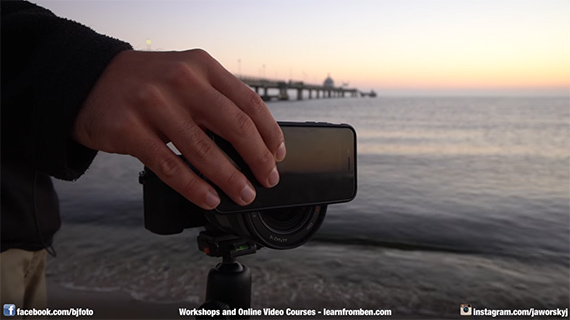How many times have you rued the fact that you chose frugality over sensibility when packing your camera bag? You’re in front of a lovely sunset by the beach. You set up your camera on a tripod, set the exposure, and then reach out for your graduated ND filter only to discover it’s not there. Well, what do you do in a situation like this? Curse your packing skills and promise to come back? No. You still take the picture. But now you use your cell phone as your ND filter:
Landscape photographer Benjamin Jaworskyj has a pretty smart hack for a graduated ND filter. Though he uses his phone to do the trick, the technique is likely to work with any other black surface like a credit card, wallet,or a black plastic cover.
All you have to do is hold the cellphone or the plastic cover against your lens while the exposure is being made. Hold the phone directly over the area of the frame that is the brightest— the area were you want to hold off light. This is similar to the concept of using a graduated filter.

Hold the cellphone in front of the lens.
Just before the exposure is done, move the cellphone away from the front of the lens allowing light from the whole of the scene to hit the sensor. By doing this you hold off light from the brightest area of the scene until the last second and keep this area from getting overexposed.
This is how a normal long exposure photo might look without the cellphone:

Regular long exposure photo
And this is how a long exposure photo looks using this neat trick:

With the ‘cellphone filter’
Some Considerations
- This technique will only work when you’re making a long exposure (3 seconds or longer).
- Hold the cellphone as close to the lens as possible.
- But, do no touch the lens with your phone.
- Always use a tripod or have a way to steady the camera when using long exposures.
One more thing to keep in mind. If you want to avoid hard edges in the final shot, use a technique commonly known as feathering. You move the cellphone up and down while the exposure is made before moving it away completely. That way there won’t be hard edges in the final image.
Like this technique? Share what you think of it in the comments below.
Like This Article?
Don't Miss The Next One!
Join over 100,000 photographers of all experience levels who receive our free photography tips and articles to stay current:






Been done so many times using just about anything :-D I’ve even used a sock!
http://icelandaurora.com/photo-tutorials/2014/07/tonys-magic-cloth-technique/